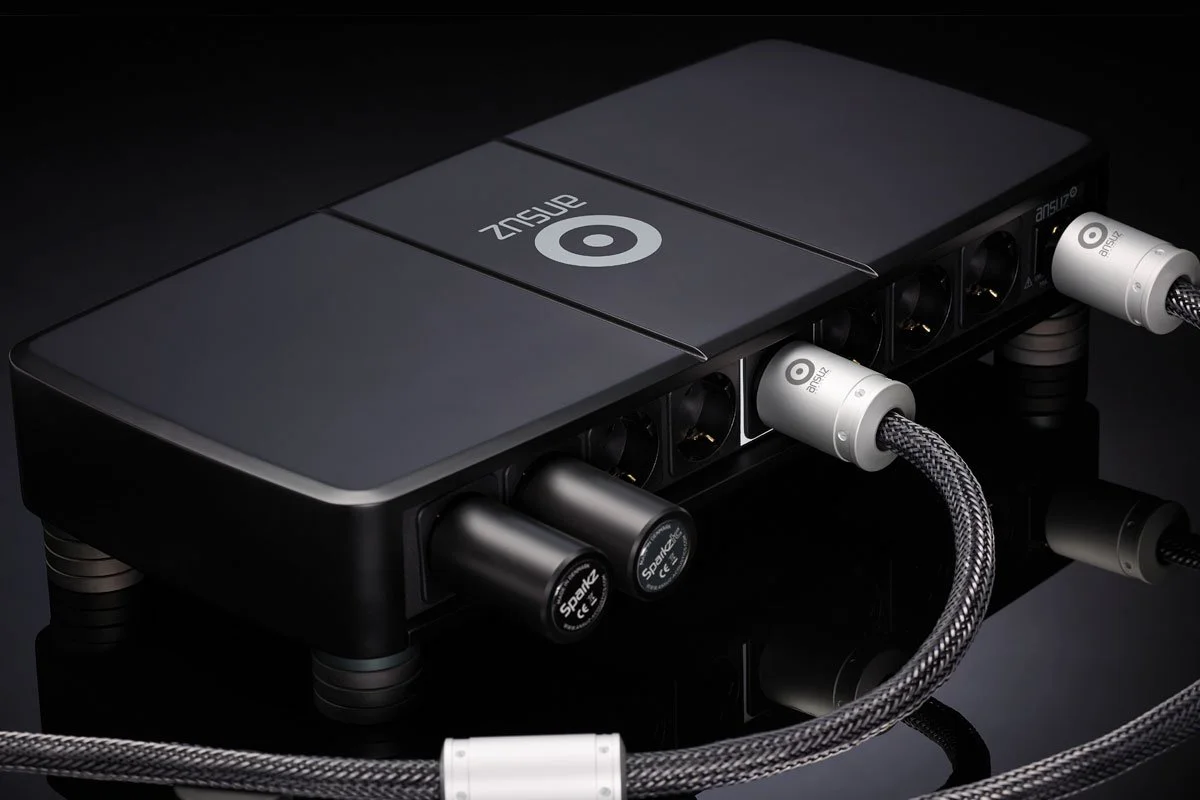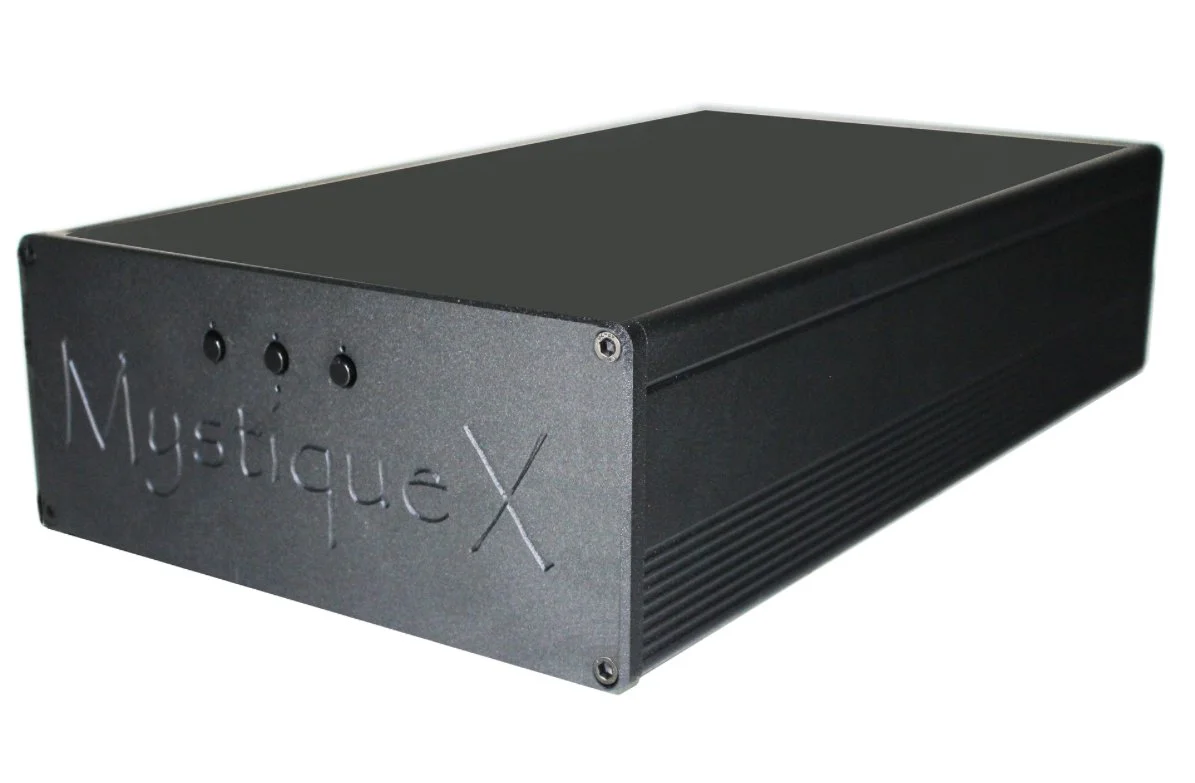Ansuz Acoustics Mainz8 C2 Power Distributor
At €5000, the Ansuz Acoustics Mainz8 C2 Power Distributor is a good-looking, tech-filled, expensive power conditioner. Because of the well-documented problems with dirty power, city grids, RF, etc, a competent power conditioner is an essential component in a quality reference system. Don’t let anybody in this business tell you differently. Even Victoria, with its rare brownouts, no heavy industry, and very clean, stable power, benefits from good conditioning.
We have reviewed several conditioners at Audiophilia and I have experience with many in stores and at shows. There are some very good conditioners out there and some duds that kneecap your system with poor tech implementation. Do your research and buyer beware.
My conditioner journey began with a dunk in the deep end: carrots were offered during speaker shopping in my youth, a decision made at the top of my budget; then the salesman played the same system the next day after my purchase decision with an MIT “power conditioner” thrown in. “WTF is that?” The difference post-MIT from Toronto's slummy Queen Street East power was astonishing. And at only a $2000 premium! Oh? Sadness (and some sulking) followed and no purchases. More research was required. It wasn’t a pleasant “first time”.
My primary power conditioning components over the past ten years have been from AudioQuest and PS Audio—AudioQuest Niagara 5000 Low-Z Power | Noise-Dissipation System (USD$3995) and AudioQuest Niagara 1200 Low-Z Power | Noise-Dissipation System (USD$995) and PS Audio DirectStream Power Plant 12 (USD $4999)—both companies tackle the sticky problem of conditioning in completely different ways. I’m sure all prices have increased significantly since my reviews.
The new Mainz8 C2 from Ansuz Acoustics (€5000) under review utilizes yet another topology. While I very much enjoyed the PS Audio Power Plant 12 in my system, I leaned towards the AudioQuest philosophy and had excellent results with both the 5000 and the entry-level 1200. It has been the 1200 that has tempered my system for the past few years. It brings a “fresher” disposition to my system compared to the more advanced, “hands-on” PS Audio, if not quite as jet black in the background (for more dollars, the AQ 5000 matches the PS’ “blackness”).
Be aware that Ansuz eschews power conditioning based on transformers and capacitors. Notice the Ansuz name, “Distributor”. With those topologies and design cues, the team believes sound and dynamics get bogged down and ameliorate your system's dynamic and musical effects.
During these past few years, I’ve had many conversations with my friend Lars Kristensen of Audio Group Denmark (AGD), the parent company of Ansuz Acoustics. He believes the technologies in many of their products, most from the mind of brilliant engineer Michael BØRRESEN, are there to eliminate unwanted noise from your system by lowering the floor as much humanly possible without changing, modifying or destroying your hard-fought and very specific curated sound. Not an easy task when important technologies insist on impacting the chains of the audio command. Interestingly, with all the star Danish gear sent to me over the past couple of years, Kristensen and his AGD team reckon we are only at a 20% threshold of noise reduction.
My Use
A big thank you to the wonderful team at AGD for shipping from the home office in Aalborg to the island (look for videos and an AGD factory tour in November).
I used the Mainz8 C2 in conjunction with Ansuz cables, a full C2 loom, review coming soon.
The Mainz8 C2 has 8 outlets with the 5th from the left outlined in white. This is the preferred outlet for your preamplifier or integrated amplifier because of Ansuz’s use of “star grounding” (more on this below). Ansuz produced a good how-to video here.
The unit dimensions are 495x236x78 mm with a weight of 5.3 kg.
Tech
As always with these expensive, advanced-tech conditioning boxes, the devil’s in the details. And with Ansuz, it always comes down to three or four of what Ansuz calls “groundbreaking advancements in noise reduction and resonance control”. And manufacturing materials.
For casing, we get a composite. Ansuz says: “The cabinet design is designed to eliminate sonic distortion. Disturbing sonic influences emanate from cabinets made mostly of aluminum. To eliminate this sonic distortion, the challenge was to minimize the use of aluminum in the cabinet. Ansuz’s sister company Aavik began testing various materials and designed an innovative natural-based composite material which reduces the mechanical influence, particularly the hysteresis.”
The Ansuz Mainz8 C2 Power Distributor provides incredibly low grounding impedance. There is almost no noise transference from the power distributor to your power cables. Ansuz suggests: “Voltage also carries disturbing noise, which has a negative impact on the electronics of audio components. Ansuz Star ground technology prevents this disturbing noise from ’bleeding’ into the electronics of all audio components connected to the power distributor. Since this star ground point has the best ground impedance, all sockets in the power distributor are grounded from here.”
The Tesla coils so favoured by AGD worked beautifully in the SORTZ termination plugs I reviewed last month. Ansuz is very high on the technology and the coils’ implementation:
The key operating principle of the Ansuz Tesla coil is to have two coils wound in opposite directions—one coil and one counter coil. In Ansuz's words, this is called “A double inverted coil”. The two coils both carry voltage, and when one of the Tesla coils encounters a voltage spike, a counter spike is activated to eliminate the noise. Adding more Tesla coils in parallel increases the noise cancellation and the perceived blackness in the music increases significantly along with the purity and clarity of the sound.
If all that goodness was not enough, analog dither technology is also used. The tech originated in radar where it ensured signal and range. Ansuz adopted the technology: “The active Tesla coils send pulsating signals at precisely defined frequencies. These signals are sent in anti-phase. This significantly amplifies the musical signal and eliminates the background noise floor.”
Every time I shop talk with Kristensen he gets these little glints in his eye. He is justifiably proud of the team’s accomplishments. He sent over a couple of pieces of kit he says improve the Mainz8 C2’s performance to even greater heights. They also raise the price significantly. These are the Darkz resonance control devices that fit perfectly under most AGD gear. Once heard under any of the equipment, they are awfully difficult to resist. But resist I did. I will report about the Darkz in a targeted review. They deserve it. Oh, and the tiny metal balls that sit on the Darkz and under the primary kit? Kristensen, glinting again, said the original titanium balls are excellent but tungsten sounds better. So he sent a replacement bag o balls! But all those findings will have to wait for the upcoming Darkz review.
My Mainz8 C2 perched on 4 Darkz resonance pucks (Darkz review forthcoming).
Back to the naked Mainz8 C2 (€5000).
Sound
I can report my carefully curated sound was left immaculate and touched only by the fact that more relevant information was sent through the cables and the music was heard from a deep black background. Conditioning “tells” like “background” and “black” were superseded by an invisible component. The dynamic range from ppp to fff was left intact and small, minute, in-the-weeds details rang through clearly. Slowly but surely, the Mainz8 will impress you and the music at an almost sub-atomic level. Once heard, it’ll impress you immediately, but give it time and you’ll hear even more remarkable details and the artist's intent.
Like the SORTZ, the Mainz8 continues the Ansuz “do no harm” philosophy to sound. My other examples also did that to a certain degree, but I found the Mainz8 makes my listening more immersive. More complete. I fear no detail is lost. And in concert with the BØRRESEN Acoustics 01 Silver Supreme Loudspeakers and the Ansuz cables and other devices, I hear my music anew. Magical.
I just received the new Nonesuch Records John Adams Collected Works CD box set for review. 40 CDs worth. Music from grand opera, solo piano, chamber music, concertos, electronica, and large-scale orchestral. An amazing life’s work. Full review coming.
But this turned out to be the perfect box to test the limits and performance of the Mainz8. In contrast with my Niagara 1200, Adams’ incredible music was more dynamic and had more lifeblood. Phrases were energized, performances more profound.
A perfect example was the gorgeous piano concerto of 1989, Eros Piano, written for Paul Crossley. It’s representative of another side of the usually frenetic, loud, brash, brilliant, ultra rhythmic Adams style, more akin to Bill Evans and the fabulous Japanese colourist Toru Takamitsu (Adams wrote the piece after a meeting with the Japanese composer). The strings of the London Sinfonietta have a lushness that I did not hear with other conditioners and the very high piano notes and soundboard reflections were heard so clearly. I love that in sound. The piano is always difficult to capture in recordings—its power and percussiveness, especially. The Mainz8 C2 did a superb job at giving this listener the full monty. Nothing went missing.
And when things get thorny as they eventually do with Adams, you’ll need to gear to unravel it all and lay it out as the engineer envisaged. The Mainz8 does this exceptionally well. So when Adams’ orchestral masterpiece Harmonielehere (1985) let’s rip, or the 200 singers in a chorus, “Wild Nights” from Harmonium, make a bigger rip, everything is balanced and as overwhelming an event as the rest of your gear, space and ears will allow.
The unit will not colour, diminish or exacerbate sound or volume. For example, the earlier recording of Harmonielehere, originally an ECM product, was reticent and smooth but ultimately not as satisfying as the far more dynamic later Berlin Phil version of Harmonielehere (both are included in the box). The Berlin live recording (on the orchestra’s label) separates the multitudinous string lines so clearly. The Mainz8 lapped up the dynamics and the instrumental separation and accurately represented the earlier, slightly inhibited version. No dynamic lipstick and rouge.
The Mainz8 C2 (€5000) will always help and never hinder. And in the most beautiful and musical way. A superb achievement.
Conclusion
As always, you don’t have to go big with Ansuz and can dip your toes at their “entry-level” versions of most of their gear. As such, there is the Mainz8 X (€1000), Mainz8 X-TC (€1500), Mainz8 A2 (€3500) and so on up to the Mainz8 D-TC Supreme at a whopping €36,000. Try and hear one in your system that suits your budget. I think you’ll be very impressed.
Further information: Ansuz Acoustics







